Critical Analysis of Articles on Leadership and Servant Leadership
VerifiedAdded on 2023/04/07
|11
|2412
|129
Report
AI Summary
This report presents a critical analysis of two articles concerning leadership styles, with a specific emphasis on servant leadership. The analysis begins with an executive summary and introduction, followed by a detailed critique that compares the arguments presented by the authors, explores theoretical perspectives, and examines the conclusions drawn in each article. The report highlights the different approaches to defining servant leadership and its relationship to overall leadership styles, with one article suggesting servant leadership as an added advantage and the other emphasizing its imperative nature for effective leadership. The report also includes a discussion of leadership theories, such as the Behavioural Theory and the Trait Theory, and concludes with a reflection on the learning experience gained from the analysis. The report aims to clarify the importance of leadership and the adoption of appropriate leadership styles for effective management and organizational change, as supported by the provided articles. This report is intended for students studying leadership and management, and is available on Desklib, a platform providing AI-based study tools.
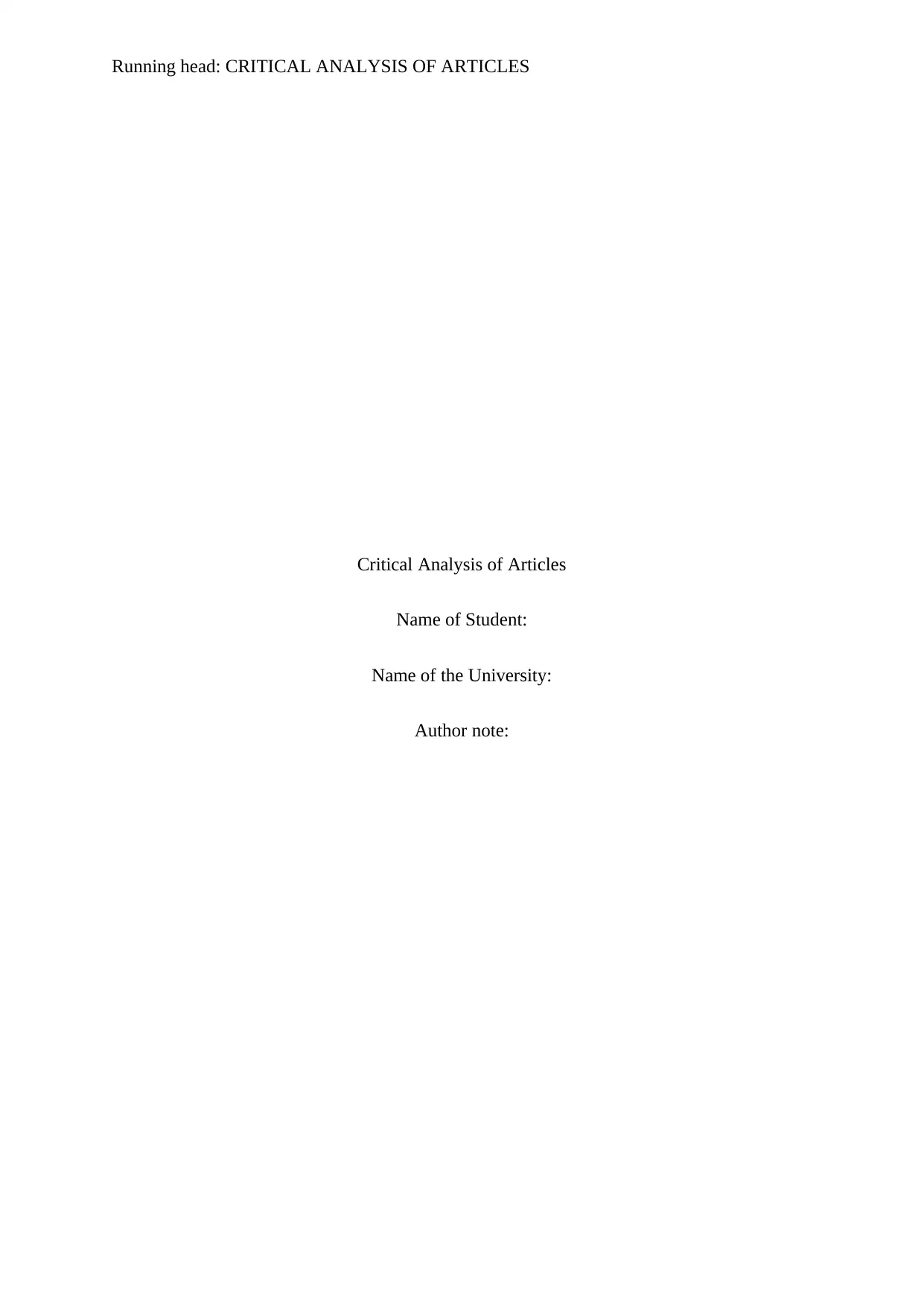
Running head: CRITICAL ANALYSIS OF ARTICLES
Critical Analysis of Articles
Name of Student:
Name of the University:
Author note:
Critical Analysis of Articles
Name of Student:
Name of the University:
Author note:
Paraphrase This Document
Need a fresh take? Get an instant paraphrase of this document with our AI Paraphraser
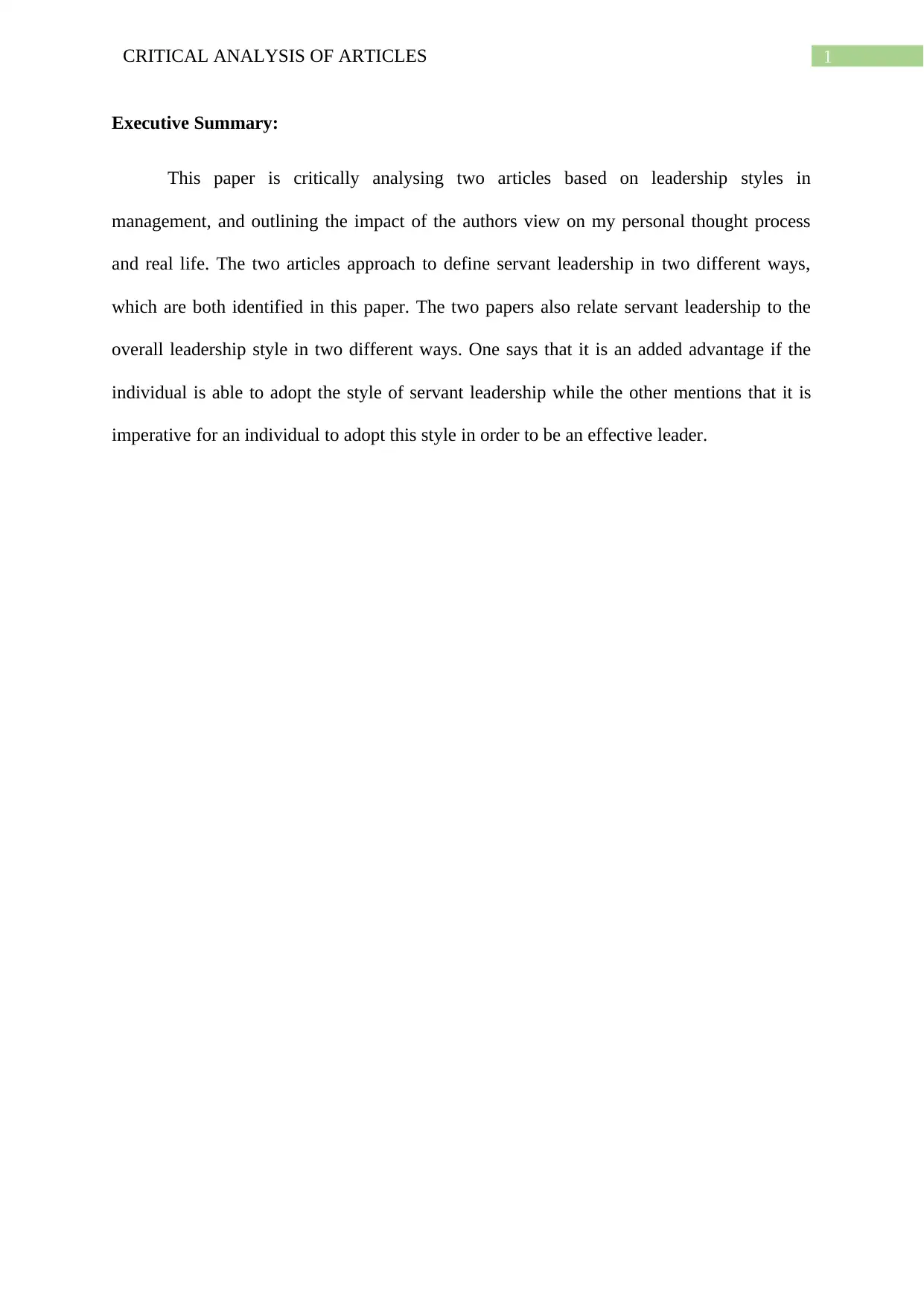
1CRITICAL ANALYSIS OF ARTICLES
Executive Summary:
This paper is critically analysing two articles based on leadership styles in
management, and outlining the impact of the authors view on my personal thought process
and real life. The two articles approach to define servant leadership in two different ways,
which are both identified in this paper. The two papers also relate servant leadership to the
overall leadership style in two different ways. One says that it is an added advantage if the
individual is able to adopt the style of servant leadership while the other mentions that it is
imperative for an individual to adopt this style in order to be an effective leader.
Executive Summary:
This paper is critically analysing two articles based on leadership styles in
management, and outlining the impact of the authors view on my personal thought process
and real life. The two articles approach to define servant leadership in two different ways,
which are both identified in this paper. The two papers also relate servant leadership to the
overall leadership style in two different ways. One says that it is an added advantage if the
individual is able to adopt the style of servant leadership while the other mentions that it is
imperative for an individual to adopt this style in order to be an effective leader.
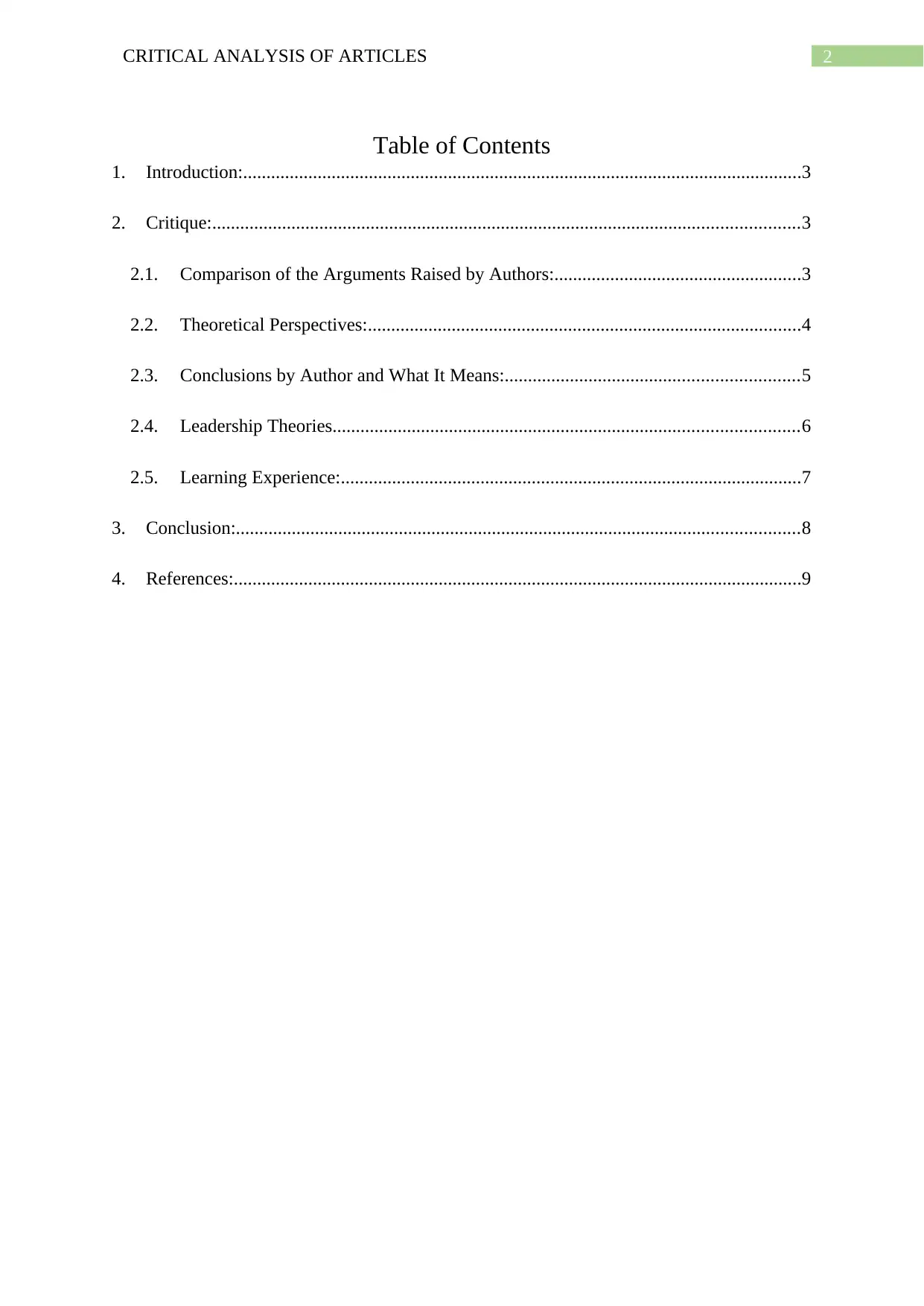
2CRITICAL ANALYSIS OF ARTICLES
Table of Contents
1. Introduction:........................................................................................................................3
2. Critique:..............................................................................................................................3
2.1. Comparison of the Arguments Raised by Authors:.....................................................3
2.2. Theoretical Perspectives:.............................................................................................4
2.3. Conclusions by Author and What It Means:...............................................................5
2.4. Leadership Theories....................................................................................................6
2.5. Learning Experience:...................................................................................................7
3. Conclusion:.........................................................................................................................8
4. References:..........................................................................................................................9
Table of Contents
1. Introduction:........................................................................................................................3
2. Critique:..............................................................................................................................3
2.1. Comparison of the Arguments Raised by Authors:.....................................................3
2.2. Theoretical Perspectives:.............................................................................................4
2.3. Conclusions by Author and What It Means:...............................................................5
2.4. Leadership Theories....................................................................................................6
2.5. Learning Experience:...................................................................................................7
3. Conclusion:.........................................................................................................................8
4. References:..........................................................................................................................9
⊘ This is a preview!⊘
Do you want full access?
Subscribe today to unlock all pages.

Trusted by 1+ million students worldwide
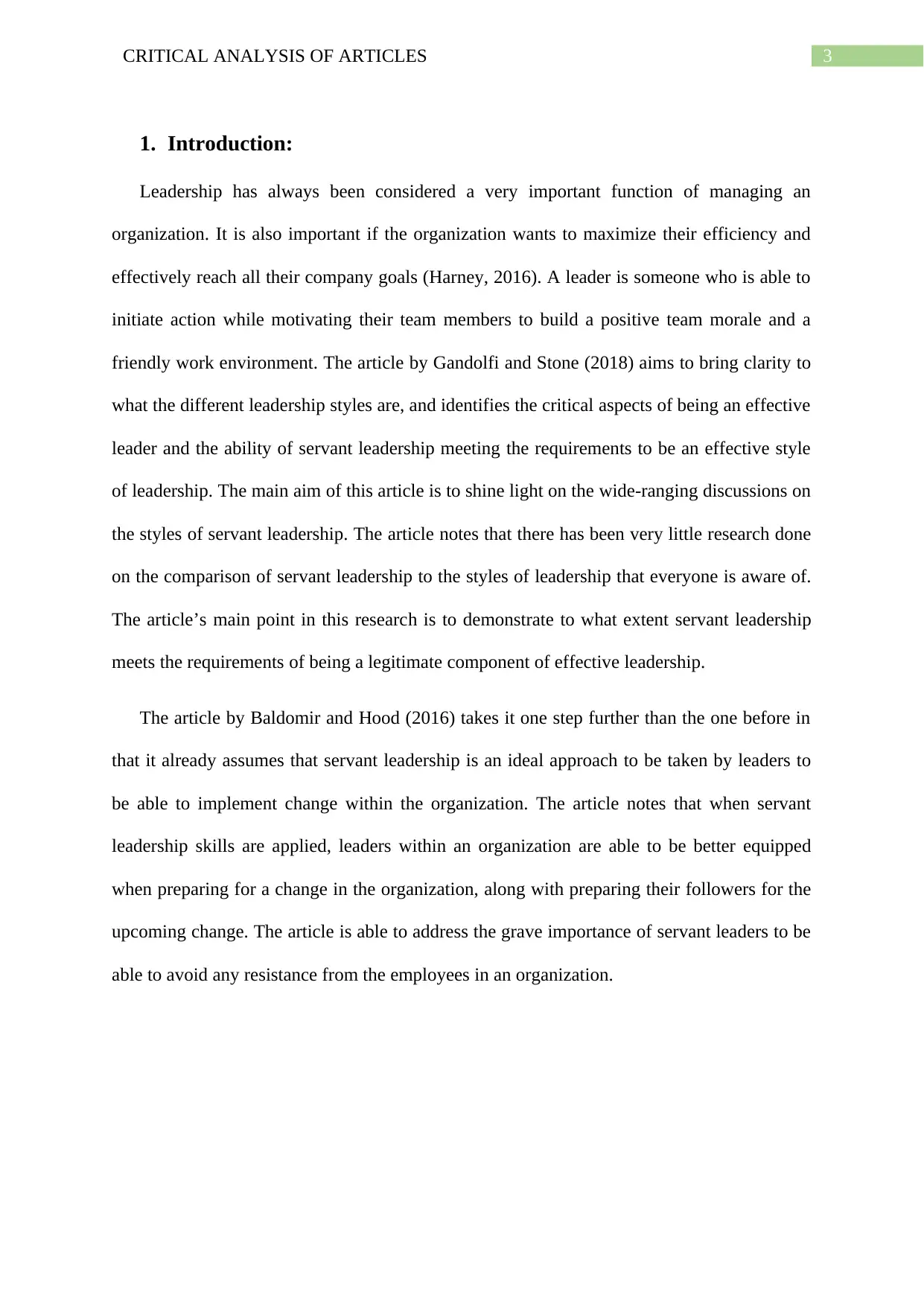
3CRITICAL ANALYSIS OF ARTICLES
1. Introduction:
Leadership has always been considered a very important function of managing an
organization. It is also important if the organization wants to maximize their efficiency and
effectively reach all their company goals (Harney, 2016). A leader is someone who is able to
initiate action while motivating their team members to build a positive team morale and a
friendly work environment. The article by Gandolfi and Stone (2018) aims to bring clarity to
what the different leadership styles are, and identifies the critical aspects of being an effective
leader and the ability of servant leadership meeting the requirements to be an effective style
of leadership. The main aim of this article is to shine light on the wide-ranging discussions on
the styles of servant leadership. The article notes that there has been very little research done
on the comparison of servant leadership to the styles of leadership that everyone is aware of.
The article’s main point in this research is to demonstrate to what extent servant leadership
meets the requirements of being a legitimate component of effective leadership.
The article by Baldomir and Hood (2016) takes it one step further than the one before in
that it already assumes that servant leadership is an ideal approach to be taken by leaders to
be able to implement change within the organization. The article notes that when servant
leadership skills are applied, leaders within an organization are able to be better equipped
when preparing for a change in the organization, along with preparing their followers for the
upcoming change. The article is able to address the grave importance of servant leaders to be
able to avoid any resistance from the employees in an organization.
1. Introduction:
Leadership has always been considered a very important function of managing an
organization. It is also important if the organization wants to maximize their efficiency and
effectively reach all their company goals (Harney, 2016). A leader is someone who is able to
initiate action while motivating their team members to build a positive team morale and a
friendly work environment. The article by Gandolfi and Stone (2018) aims to bring clarity to
what the different leadership styles are, and identifies the critical aspects of being an effective
leader and the ability of servant leadership meeting the requirements to be an effective style
of leadership. The main aim of this article is to shine light on the wide-ranging discussions on
the styles of servant leadership. The article notes that there has been very little research done
on the comparison of servant leadership to the styles of leadership that everyone is aware of.
The article’s main point in this research is to demonstrate to what extent servant leadership
meets the requirements of being a legitimate component of effective leadership.
The article by Baldomir and Hood (2016) takes it one step further than the one before in
that it already assumes that servant leadership is an ideal approach to be taken by leaders to
be able to implement change within the organization. The article notes that when servant
leadership skills are applied, leaders within an organization are able to be better equipped
when preparing for a change in the organization, along with preparing their followers for the
upcoming change. The article is able to address the grave importance of servant leaders to be
able to avoid any resistance from the employees in an organization.
Paraphrase This Document
Need a fresh take? Get an instant paraphrase of this document with our AI Paraphraser
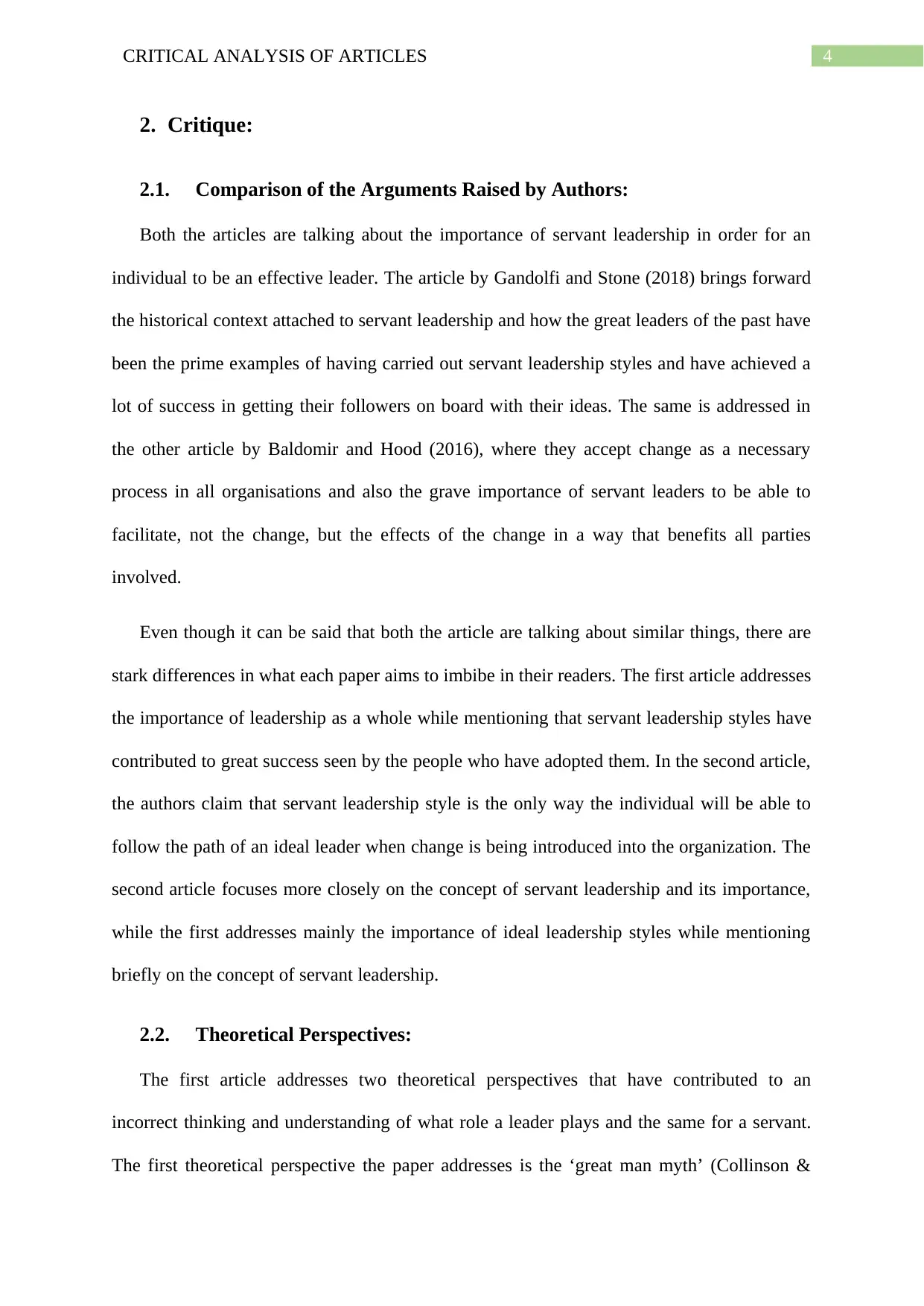
4CRITICAL ANALYSIS OF ARTICLES
2. Critique:
2.1. Comparison of the Arguments Raised by Authors:
Both the articles are talking about the importance of servant leadership in order for an
individual to be an effective leader. The article by Gandolfi and Stone (2018) brings forward
the historical context attached to servant leadership and how the great leaders of the past have
been the prime examples of having carried out servant leadership styles and have achieved a
lot of success in getting their followers on board with their ideas. The same is addressed in
the other article by Baldomir and Hood (2016), where they accept change as a necessary
process in all organisations and also the grave importance of servant leaders to be able to
facilitate, not the change, but the effects of the change in a way that benefits all parties
involved.
Even though it can be said that both the article are talking about similar things, there are
stark differences in what each paper aims to imbibe in their readers. The first article addresses
the importance of leadership as a whole while mentioning that servant leadership styles have
contributed to great success seen by the people who have adopted them. In the second article,
the authors claim that servant leadership style is the only way the individual will be able to
follow the path of an ideal leader when change is being introduced into the organization. The
second article focuses more closely on the concept of servant leadership and its importance,
while the first addresses mainly the importance of ideal leadership styles while mentioning
briefly on the concept of servant leadership.
2.2. Theoretical Perspectives:
The first article addresses two theoretical perspectives that have contributed to an
incorrect thinking and understanding of what role a leader plays and the same for a servant.
The first theoretical perspective the paper addresses is the ‘great man myth’ (Collinson &
2. Critique:
2.1. Comparison of the Arguments Raised by Authors:
Both the articles are talking about the importance of servant leadership in order for an
individual to be an effective leader. The article by Gandolfi and Stone (2018) brings forward
the historical context attached to servant leadership and how the great leaders of the past have
been the prime examples of having carried out servant leadership styles and have achieved a
lot of success in getting their followers on board with their ideas. The same is addressed in
the other article by Baldomir and Hood (2016), where they accept change as a necessary
process in all organisations and also the grave importance of servant leaders to be able to
facilitate, not the change, but the effects of the change in a way that benefits all parties
involved.
Even though it can be said that both the article are talking about similar things, there are
stark differences in what each paper aims to imbibe in their readers. The first article addresses
the importance of leadership as a whole while mentioning that servant leadership styles have
contributed to great success seen by the people who have adopted them. In the second article,
the authors claim that servant leadership style is the only way the individual will be able to
follow the path of an ideal leader when change is being introduced into the organization. The
second article focuses more closely on the concept of servant leadership and its importance,
while the first addresses mainly the importance of ideal leadership styles while mentioning
briefly on the concept of servant leadership.
2.2. Theoretical Perspectives:
The first article addresses two theoretical perspectives that have contributed to an
incorrect thinking and understanding of what role a leader plays and the same for a servant.
The first theoretical perspective the paper addresses is the ‘great man myth’ (Collinson &
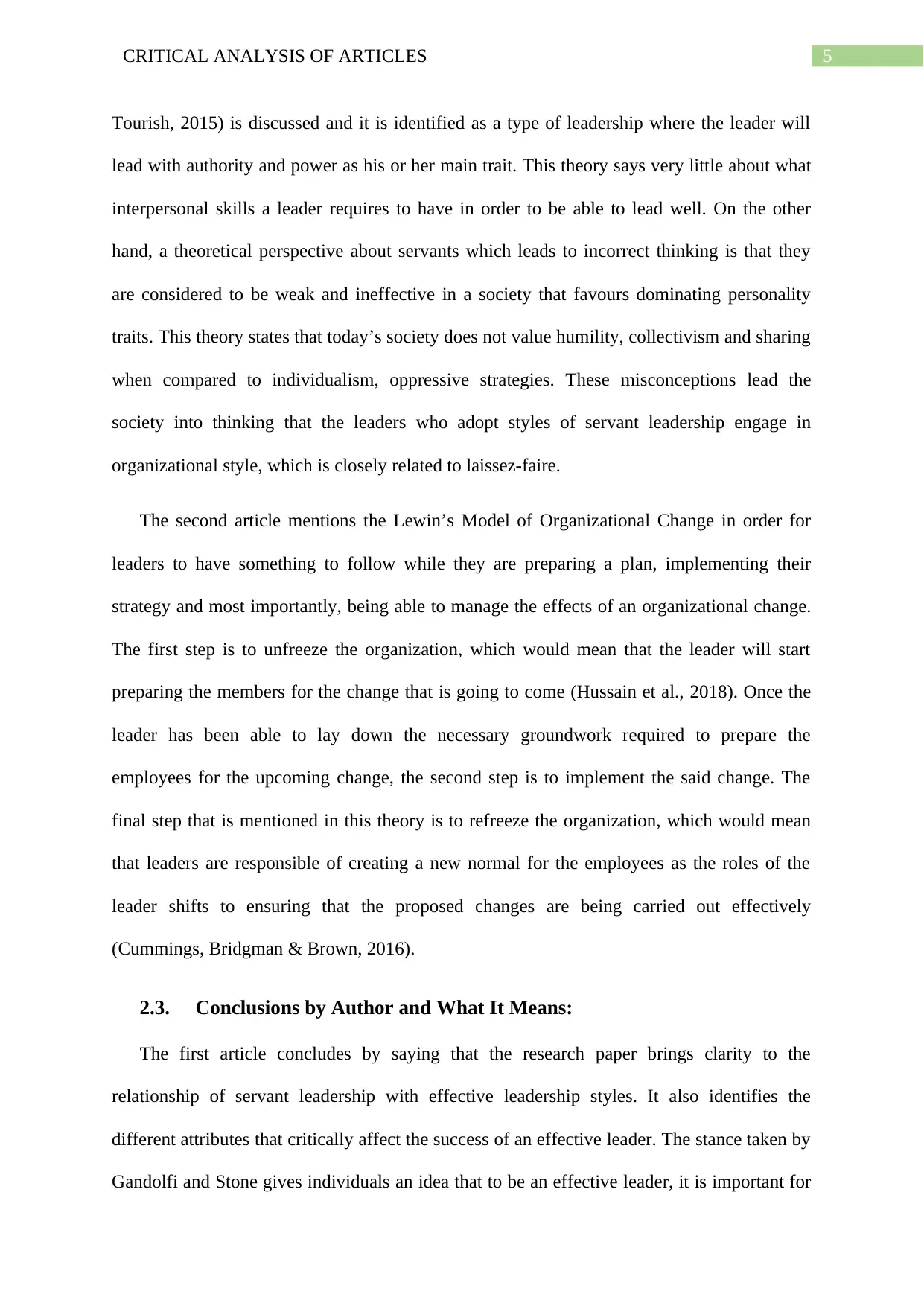
5CRITICAL ANALYSIS OF ARTICLES
Tourish, 2015) is discussed and it is identified as a type of leadership where the leader will
lead with authority and power as his or her main trait. This theory says very little about what
interpersonal skills a leader requires to have in order to be able to lead well. On the other
hand, a theoretical perspective about servants which leads to incorrect thinking is that they
are considered to be weak and ineffective in a society that favours dominating personality
traits. This theory states that today’s society does not value humility, collectivism and sharing
when compared to individualism, oppressive strategies. These misconceptions lead the
society into thinking that the leaders who adopt styles of servant leadership engage in
organizational style, which is closely related to laissez-faire.
The second article mentions the Lewin’s Model of Organizational Change in order for
leaders to have something to follow while they are preparing a plan, implementing their
strategy and most importantly, being able to manage the effects of an organizational change.
The first step is to unfreeze the organization, which would mean that the leader will start
preparing the members for the change that is going to come (Hussain et al., 2018). Once the
leader has been able to lay down the necessary groundwork required to prepare the
employees for the upcoming change, the second step is to implement the said change. The
final step that is mentioned in this theory is to refreeze the organization, which would mean
that leaders are responsible of creating a new normal for the employees as the roles of the
leader shifts to ensuring that the proposed changes are being carried out effectively
(Cummings, Bridgman & Brown, 2016).
2.3. Conclusions by Author and What It Means:
The first article concludes by saying that the research paper brings clarity to the
relationship of servant leadership with effective leadership styles. It also identifies the
different attributes that critically affect the success of an effective leader. The stance taken by
Gandolfi and Stone gives individuals an idea that to be an effective leader, it is important for
Tourish, 2015) is discussed and it is identified as a type of leadership where the leader will
lead with authority and power as his or her main trait. This theory says very little about what
interpersonal skills a leader requires to have in order to be able to lead well. On the other
hand, a theoretical perspective about servants which leads to incorrect thinking is that they
are considered to be weak and ineffective in a society that favours dominating personality
traits. This theory states that today’s society does not value humility, collectivism and sharing
when compared to individualism, oppressive strategies. These misconceptions lead the
society into thinking that the leaders who adopt styles of servant leadership engage in
organizational style, which is closely related to laissez-faire.
The second article mentions the Lewin’s Model of Organizational Change in order for
leaders to have something to follow while they are preparing a plan, implementing their
strategy and most importantly, being able to manage the effects of an organizational change.
The first step is to unfreeze the organization, which would mean that the leader will start
preparing the members for the change that is going to come (Hussain et al., 2018). Once the
leader has been able to lay down the necessary groundwork required to prepare the
employees for the upcoming change, the second step is to implement the said change. The
final step that is mentioned in this theory is to refreeze the organization, which would mean
that leaders are responsible of creating a new normal for the employees as the roles of the
leader shifts to ensuring that the proposed changes are being carried out effectively
(Cummings, Bridgman & Brown, 2016).
2.3. Conclusions by Author and What It Means:
The first article concludes by saying that the research paper brings clarity to the
relationship of servant leadership with effective leadership styles. It also identifies the
different attributes that critically affect the success of an effective leader. The stance taken by
Gandolfi and Stone gives individuals an idea that to be an effective leader, it is important for
⊘ This is a preview!⊘
Do you want full access?
Subscribe today to unlock all pages.

Trusted by 1+ million students worldwide
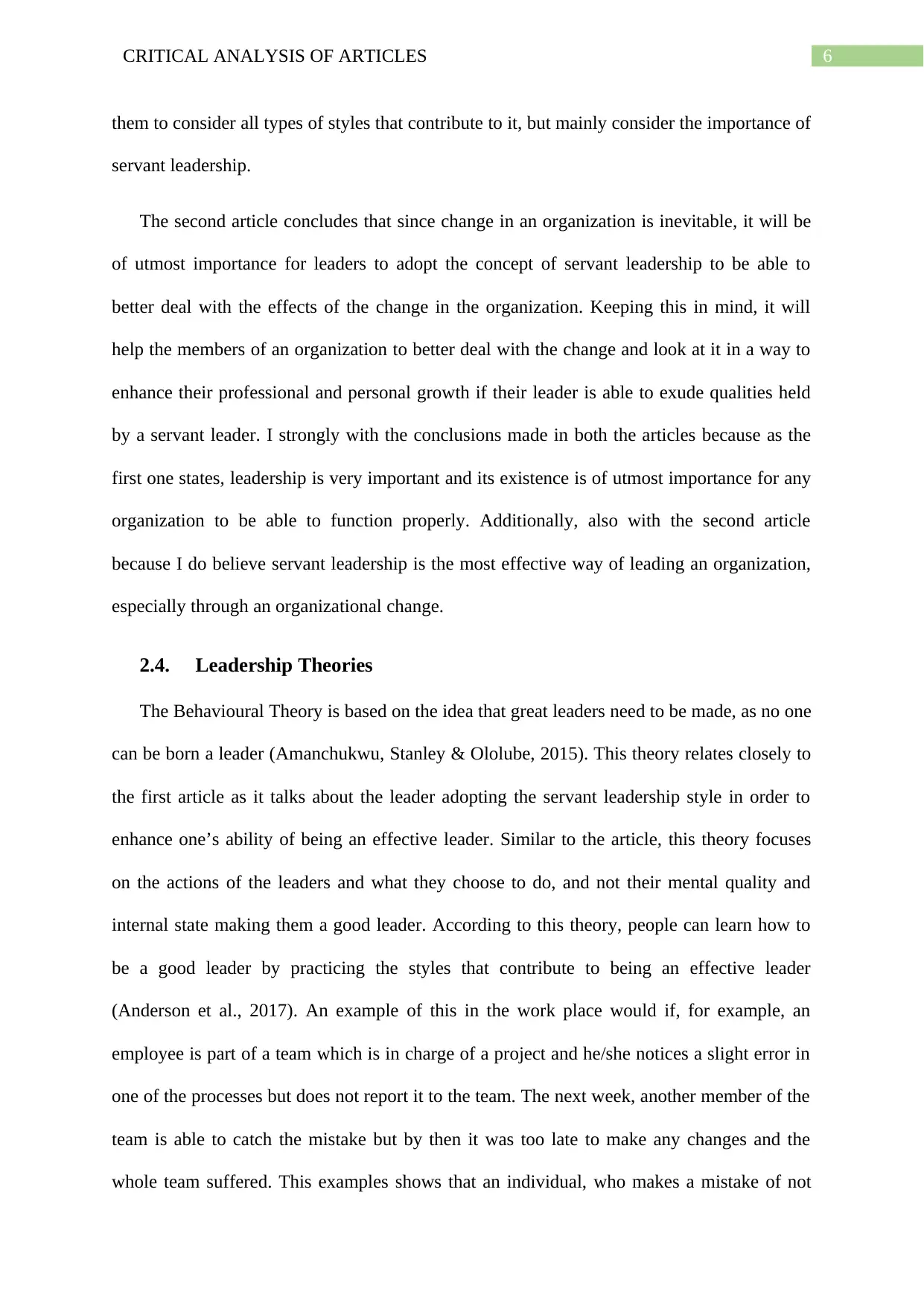
6CRITICAL ANALYSIS OF ARTICLES
them to consider all types of styles that contribute to it, but mainly consider the importance of
servant leadership.
The second article concludes that since change in an organization is inevitable, it will be
of utmost importance for leaders to adopt the concept of servant leadership to be able to
better deal with the effects of the change in the organization. Keeping this in mind, it will
help the members of an organization to better deal with the change and look at it in a way to
enhance their professional and personal growth if their leader is able to exude qualities held
by a servant leader. I strongly with the conclusions made in both the articles because as the
first one states, leadership is very important and its existence is of utmost importance for any
organization to be able to function properly. Additionally, also with the second article
because I do believe servant leadership is the most effective way of leading an organization,
especially through an organizational change.
2.4. Leadership Theories
The Behavioural Theory is based on the idea that great leaders need to be made, as no one
can be born a leader (Amanchukwu, Stanley & Ololube, 2015). This theory relates closely to
the first article as it talks about the leader adopting the servant leadership style in order to
enhance one’s ability of being an effective leader. Similar to the article, this theory focuses
on the actions of the leaders and what they choose to do, and not their mental quality and
internal state making them a good leader. According to this theory, people can learn how to
be a good leader by practicing the styles that contribute to being an effective leader
(Anderson et al., 2017). An example of this in the work place would if, for example, an
employee is part of a team which is in charge of a project and he/she notices a slight error in
one of the processes but does not report it to the team. The next week, another member of the
team is able to catch the mistake but by then it was too late to make any changes and the
whole team suffered. This examples shows that an individual, who makes a mistake of not
them to consider all types of styles that contribute to it, but mainly consider the importance of
servant leadership.
The second article concludes that since change in an organization is inevitable, it will be
of utmost importance for leaders to adopt the concept of servant leadership to be able to
better deal with the effects of the change in the organization. Keeping this in mind, it will
help the members of an organization to better deal with the change and look at it in a way to
enhance their professional and personal growth if their leader is able to exude qualities held
by a servant leader. I strongly with the conclusions made in both the articles because as the
first one states, leadership is very important and its existence is of utmost importance for any
organization to be able to function properly. Additionally, also with the second article
because I do believe servant leadership is the most effective way of leading an organization,
especially through an organizational change.
2.4. Leadership Theories
The Behavioural Theory is based on the idea that great leaders need to be made, as no one
can be born a leader (Amanchukwu, Stanley & Ololube, 2015). This theory relates closely to
the first article as it talks about the leader adopting the servant leadership style in order to
enhance one’s ability of being an effective leader. Similar to the article, this theory focuses
on the actions of the leaders and what they choose to do, and not their mental quality and
internal state making them a good leader. According to this theory, people can learn how to
be a good leader by practicing the styles that contribute to being an effective leader
(Anderson et al., 2017). An example of this in the work place would if, for example, an
employee is part of a team which is in charge of a project and he/she notices a slight error in
one of the processes but does not report it to the team. The next week, another member of the
team is able to catch the mistake but by then it was too late to make any changes and the
whole team suffered. This examples shows that an individual, who makes a mistake of not
Paraphrase This Document
Need a fresh take? Get an instant paraphrase of this document with our AI Paraphraser
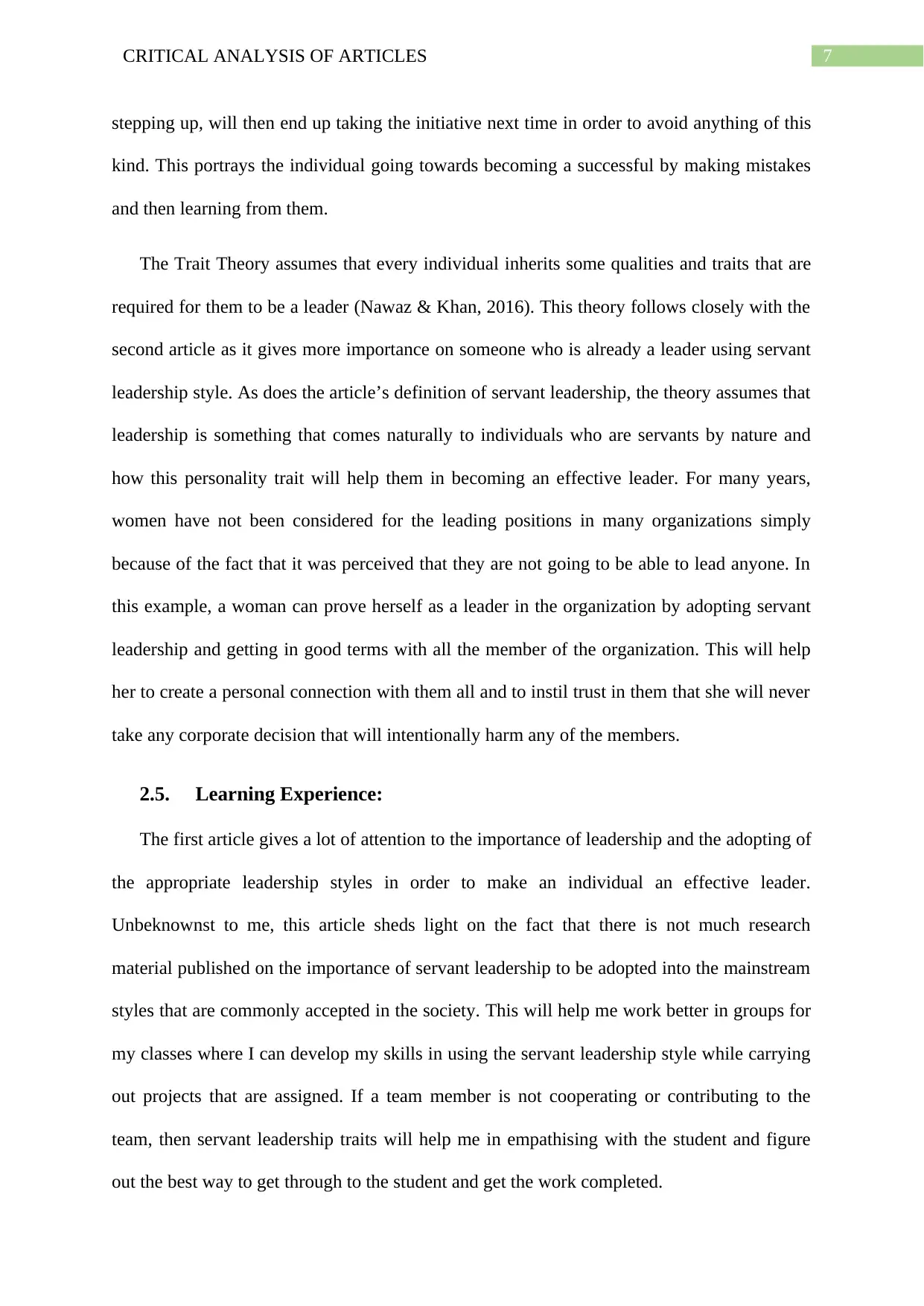
7CRITICAL ANALYSIS OF ARTICLES
stepping up, will then end up taking the initiative next time in order to avoid anything of this
kind. This portrays the individual going towards becoming a successful by making mistakes
and then learning from them.
The Trait Theory assumes that every individual inherits some qualities and traits that are
required for them to be a leader (Nawaz & Khan, 2016). This theory follows closely with the
second article as it gives more importance on someone who is already a leader using servant
leadership style. As does the article’s definition of servant leadership, the theory assumes that
leadership is something that comes naturally to individuals who are servants by nature and
how this personality trait will help them in becoming an effective leader. For many years,
women have not been considered for the leading positions in many organizations simply
because of the fact that it was perceived that they are not going to be able to lead anyone. In
this example, a woman can prove herself as a leader in the organization by adopting servant
leadership and getting in good terms with all the member of the organization. This will help
her to create a personal connection with them all and to instil trust in them that she will never
take any corporate decision that will intentionally harm any of the members.
2.5. Learning Experience:
The first article gives a lot of attention to the importance of leadership and the adopting of
the appropriate leadership styles in order to make an individual an effective leader.
Unbeknownst to me, this article sheds light on the fact that there is not much research
material published on the importance of servant leadership to be adopted into the mainstream
styles that are commonly accepted in the society. This will help me work better in groups for
my classes where I can develop my skills in using the servant leadership style while carrying
out projects that are assigned. If a team member is not cooperating or contributing to the
team, then servant leadership traits will help me in empathising with the student and figure
out the best way to get through to the student and get the work completed.
stepping up, will then end up taking the initiative next time in order to avoid anything of this
kind. This portrays the individual going towards becoming a successful by making mistakes
and then learning from them.
The Trait Theory assumes that every individual inherits some qualities and traits that are
required for them to be a leader (Nawaz & Khan, 2016). This theory follows closely with the
second article as it gives more importance on someone who is already a leader using servant
leadership style. As does the article’s definition of servant leadership, the theory assumes that
leadership is something that comes naturally to individuals who are servants by nature and
how this personality trait will help them in becoming an effective leader. For many years,
women have not been considered for the leading positions in many organizations simply
because of the fact that it was perceived that they are not going to be able to lead anyone. In
this example, a woman can prove herself as a leader in the organization by adopting servant
leadership and getting in good terms with all the member of the organization. This will help
her to create a personal connection with them all and to instil trust in them that she will never
take any corporate decision that will intentionally harm any of the members.
2.5. Learning Experience:
The first article gives a lot of attention to the importance of leadership and the adopting of
the appropriate leadership styles in order to make an individual an effective leader.
Unbeknownst to me, this article sheds light on the fact that there is not much research
material published on the importance of servant leadership to be adopted into the mainstream
styles that are commonly accepted in the society. This will help me work better in groups for
my classes where I can develop my skills in using the servant leadership style while carrying
out projects that are assigned. If a team member is not cooperating or contributing to the
team, then servant leadership traits will help me in empathising with the student and figure
out the best way to get through to the student and get the work completed.
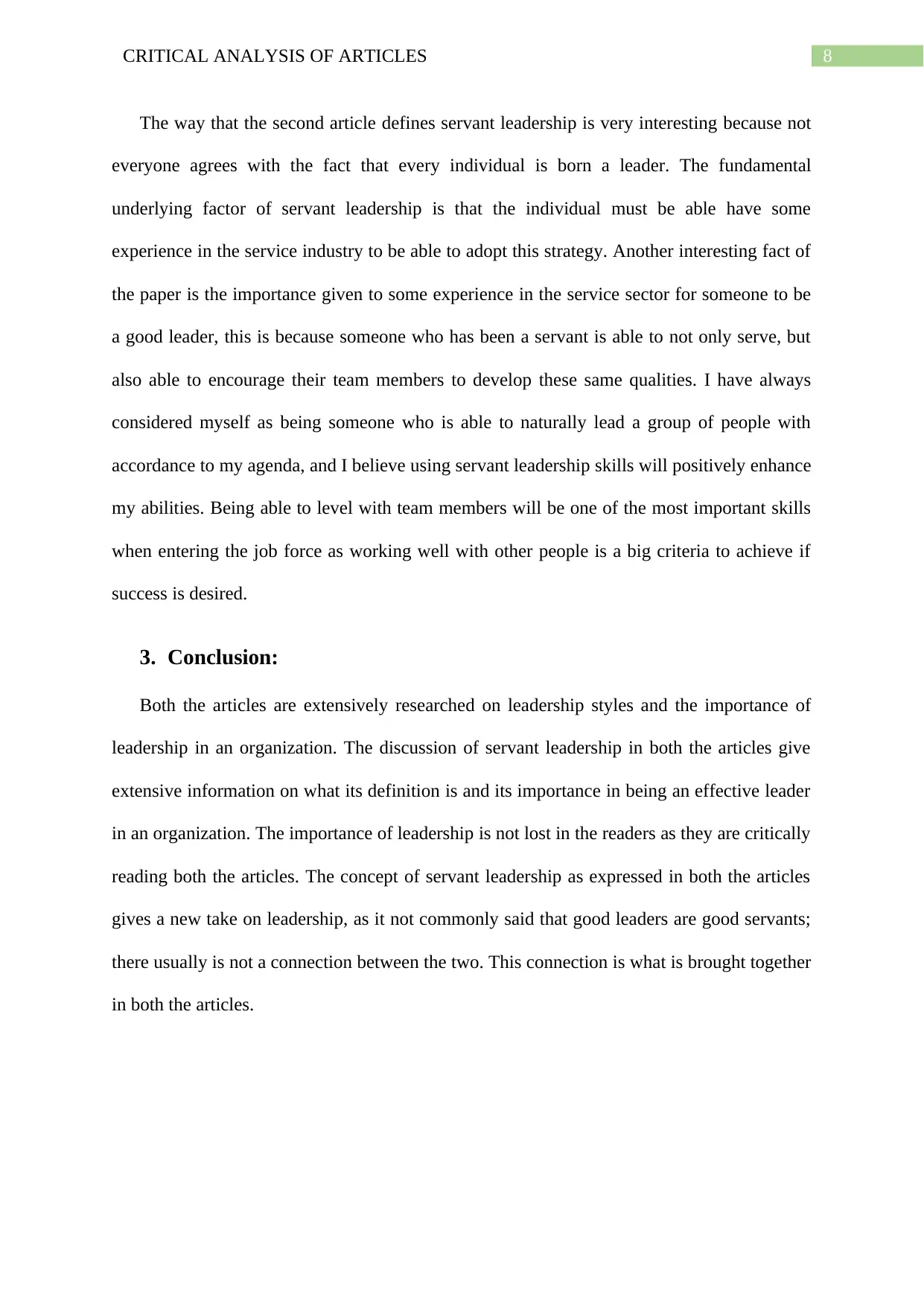
8CRITICAL ANALYSIS OF ARTICLES
The way that the second article defines servant leadership is very interesting because not
everyone agrees with the fact that every individual is born a leader. The fundamental
underlying factor of servant leadership is that the individual must be able have some
experience in the service industry to be able to adopt this strategy. Another interesting fact of
the paper is the importance given to some experience in the service sector for someone to be
a good leader, this is because someone who has been a servant is able to not only serve, but
also able to encourage their team members to develop these same qualities. I have always
considered myself as being someone who is able to naturally lead a group of people with
accordance to my agenda, and I believe using servant leadership skills will positively enhance
my abilities. Being able to level with team members will be one of the most important skills
when entering the job force as working well with other people is a big criteria to achieve if
success is desired.
3. Conclusion:
Both the articles are extensively researched on leadership styles and the importance of
leadership in an organization. The discussion of servant leadership in both the articles give
extensive information on what its definition is and its importance in being an effective leader
in an organization. The importance of leadership is not lost in the readers as they are critically
reading both the articles. The concept of servant leadership as expressed in both the articles
gives a new take on leadership, as it not commonly said that good leaders are good servants;
there usually is not a connection between the two. This connection is what is brought together
in both the articles.
The way that the second article defines servant leadership is very interesting because not
everyone agrees with the fact that every individual is born a leader. The fundamental
underlying factor of servant leadership is that the individual must be able have some
experience in the service industry to be able to adopt this strategy. Another interesting fact of
the paper is the importance given to some experience in the service sector for someone to be
a good leader, this is because someone who has been a servant is able to not only serve, but
also able to encourage their team members to develop these same qualities. I have always
considered myself as being someone who is able to naturally lead a group of people with
accordance to my agenda, and I believe using servant leadership skills will positively enhance
my abilities. Being able to level with team members will be one of the most important skills
when entering the job force as working well with other people is a big criteria to achieve if
success is desired.
3. Conclusion:
Both the articles are extensively researched on leadership styles and the importance of
leadership in an organization. The discussion of servant leadership in both the articles give
extensive information on what its definition is and its importance in being an effective leader
in an organization. The importance of leadership is not lost in the readers as they are critically
reading both the articles. The concept of servant leadership as expressed in both the articles
gives a new take on leadership, as it not commonly said that good leaders are good servants;
there usually is not a connection between the two. This connection is what is brought together
in both the articles.
⊘ This is a preview!⊘
Do you want full access?
Subscribe today to unlock all pages.

Trusted by 1+ million students worldwide
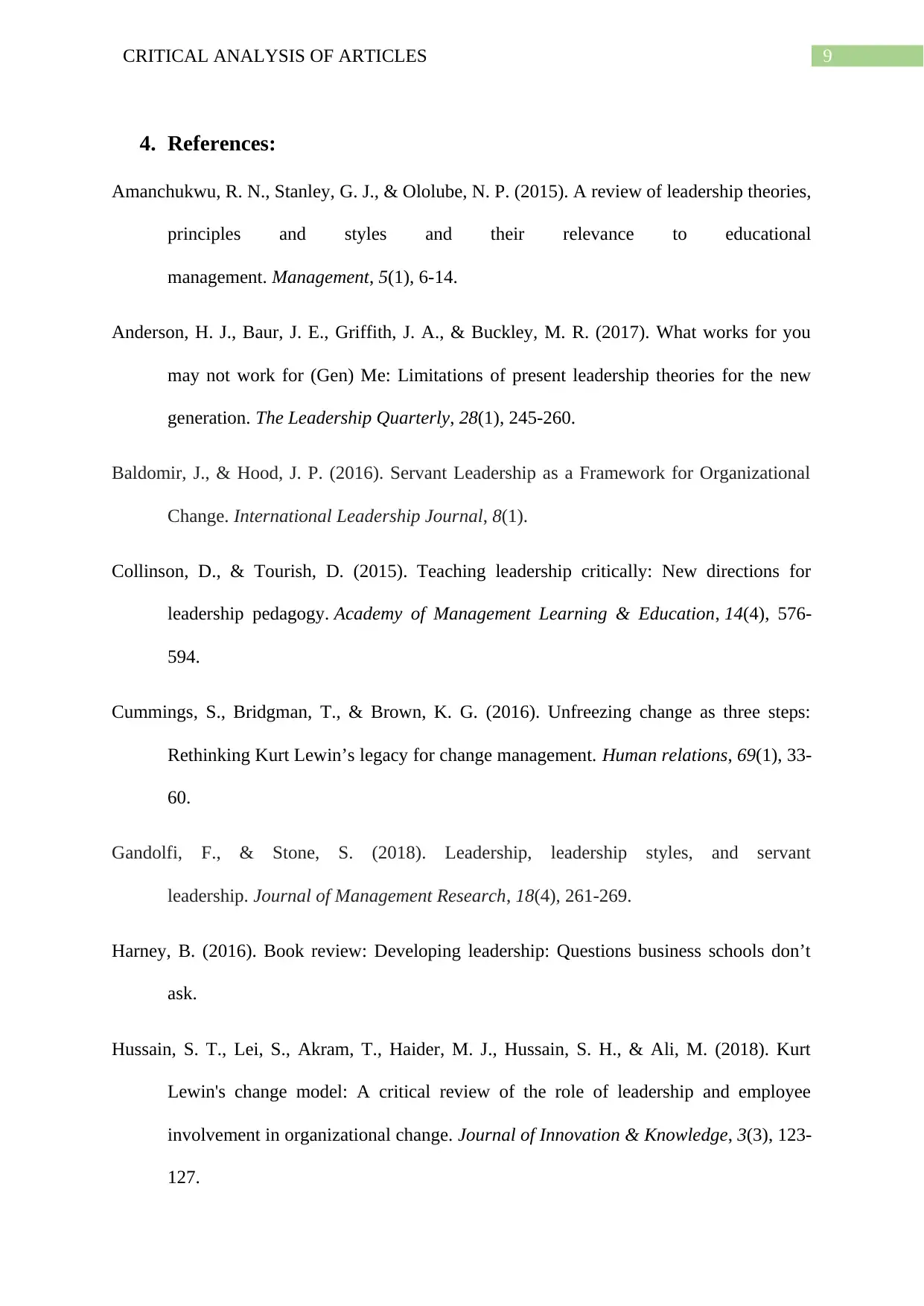
9CRITICAL ANALYSIS OF ARTICLES
4. References:
Amanchukwu, R. N., Stanley, G. J., & Ololube, N. P. (2015). A review of leadership theories,
principles and styles and their relevance to educational
management. Management, 5(1), 6-14.
Anderson, H. J., Baur, J. E., Griffith, J. A., & Buckley, M. R. (2017). What works for you
may not work for (Gen) Me: Limitations of present leadership theories for the new
generation. The Leadership Quarterly, 28(1), 245-260.
Baldomir, J., & Hood, J. P. (2016). Servant Leadership as a Framework for Organizational
Change. International Leadership Journal, 8(1).
Collinson, D., & Tourish, D. (2015). Teaching leadership critically: New directions for
leadership pedagogy. Academy of Management Learning & Education, 14(4), 576-
594.
Cummings, S., Bridgman, T., & Brown, K. G. (2016). Unfreezing change as three steps:
Rethinking Kurt Lewin’s legacy for change management. Human relations, 69(1), 33-
60.
Gandolfi, F., & Stone, S. (2018). Leadership, leadership styles, and servant
leadership. Journal of Management Research, 18(4), 261-269.
Harney, B. (2016). Book review: Developing leadership: Questions business schools don’t
ask.
Hussain, S. T., Lei, S., Akram, T., Haider, M. J., Hussain, S. H., & Ali, M. (2018). Kurt
Lewin's change model: A critical review of the role of leadership and employee
involvement in organizational change. Journal of Innovation & Knowledge, 3(3), 123-
127.
4. References:
Amanchukwu, R. N., Stanley, G. J., & Ololube, N. P. (2015). A review of leadership theories,
principles and styles and their relevance to educational
management. Management, 5(1), 6-14.
Anderson, H. J., Baur, J. E., Griffith, J. A., & Buckley, M. R. (2017). What works for you
may not work for (Gen) Me: Limitations of present leadership theories for the new
generation. The Leadership Quarterly, 28(1), 245-260.
Baldomir, J., & Hood, J. P. (2016). Servant Leadership as a Framework for Organizational
Change. International Leadership Journal, 8(1).
Collinson, D., & Tourish, D. (2015). Teaching leadership critically: New directions for
leadership pedagogy. Academy of Management Learning & Education, 14(4), 576-
594.
Cummings, S., Bridgman, T., & Brown, K. G. (2016). Unfreezing change as three steps:
Rethinking Kurt Lewin’s legacy for change management. Human relations, 69(1), 33-
60.
Gandolfi, F., & Stone, S. (2018). Leadership, leadership styles, and servant
leadership. Journal of Management Research, 18(4), 261-269.
Harney, B. (2016). Book review: Developing leadership: Questions business schools don’t
ask.
Hussain, S. T., Lei, S., Akram, T., Haider, M. J., Hussain, S. H., & Ali, M. (2018). Kurt
Lewin's change model: A critical review of the role of leadership and employee
involvement in organizational change. Journal of Innovation & Knowledge, 3(3), 123-
127.
Paraphrase This Document
Need a fresh take? Get an instant paraphrase of this document with our AI Paraphraser
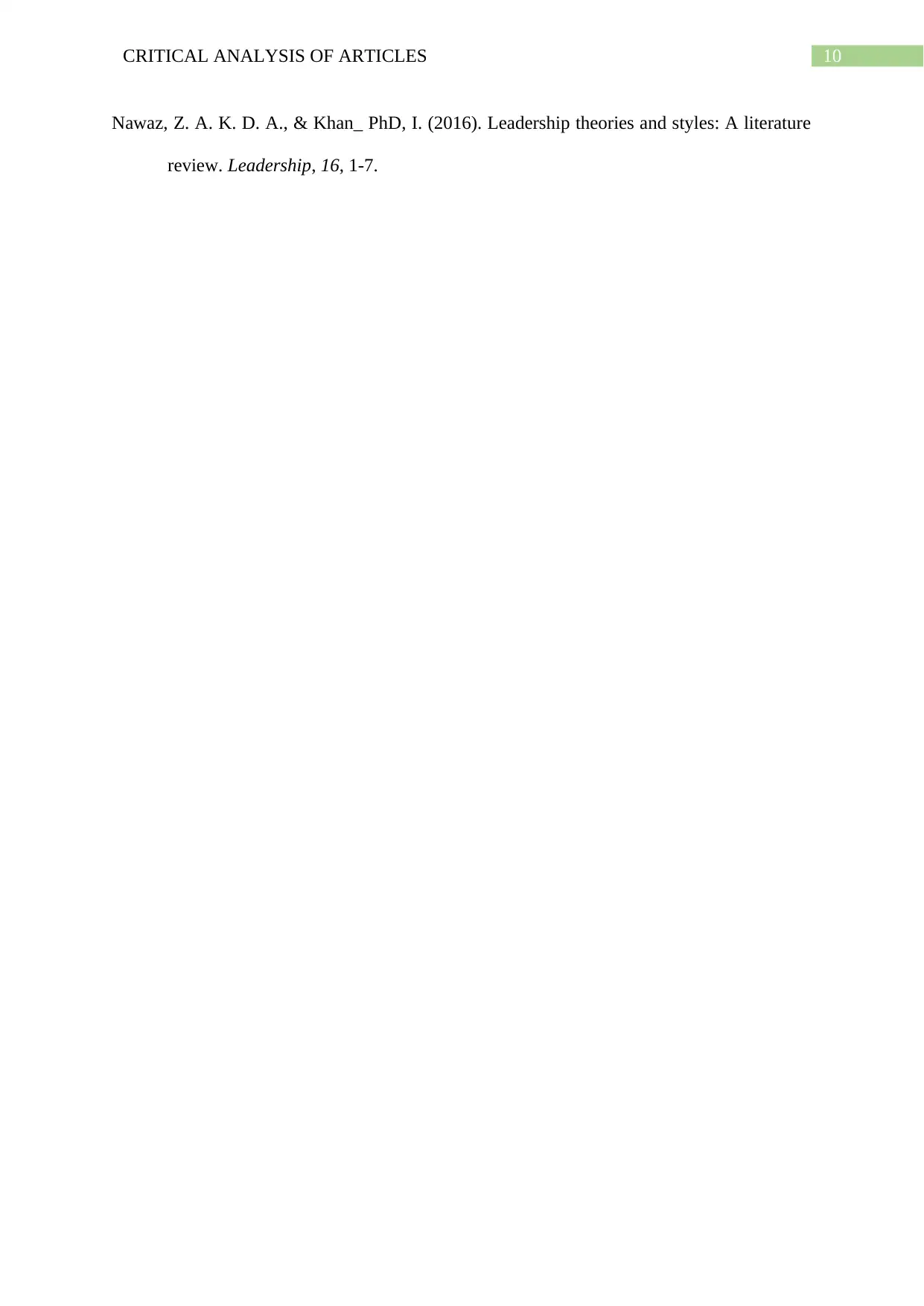
10CRITICAL ANALYSIS OF ARTICLES
Nawaz, Z. A. K. D. A., & Khan_ PhD, I. (2016). Leadership theories and styles: A literature
review. Leadership, 16, 1-7.
Nawaz, Z. A. K. D. A., & Khan_ PhD, I. (2016). Leadership theories and styles: A literature
review. Leadership, 16, 1-7.
1 out of 11
Related Documents
Your All-in-One AI-Powered Toolkit for Academic Success.
+13062052269
info@desklib.com
Available 24*7 on WhatsApp / Email
![[object Object]](/_next/static/media/star-bottom.7253800d.svg)
Unlock your academic potential
Copyright © 2020–2025 A2Z Services. All Rights Reserved. Developed and managed by ZUCOL.




